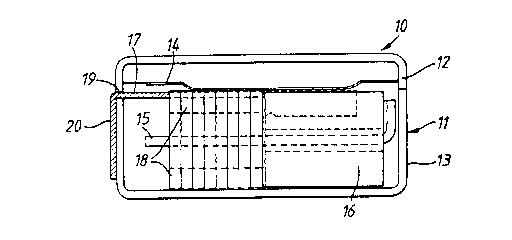Some of the information on this Web page has been provided by external sources. The Government of Canada is not responsible for the accuracy, reliability or currency of the information supplied by external sources. Users wishing to rely upon this information should consult directly with the source of the information. Content provided by external sources is not subject to official languages, privacy and accessibility requirements.
Any discrepancies in the text and image of the Claims and Abstract are due to differing posting times. Text of the Claims and Abstract are posted:
| (12) Patent: | (11) CA 2071927 |
|---|---|
| (54) English Title: | COIL ASSEMBLIES |
| (54) French Title: | BOBINES |
| Status: | Expired and beyond the Period of Reversal |
| (51) International Patent Classification (IPC): |
|
|---|---|
| (72) Inventors : |
|
| (73) Owners : |
|
| (71) Applicants : |
|
| (74) Agent: | OSLER, HOSKIN & HARCOURT LLP |
| (74) Associate agent: | |
| (45) Issued: | 1999-08-03 |
| (86) PCT Filing Date: | 1990-11-26 |
| (87) Open to Public Inspection: | 1991-06-22 |
| Examination requested: | 1997-06-06 |
| Availability of licence: | N/A |
| Dedicated to the Public: | N/A |
| (25) Language of filing: | English |
| Patent Cooperation Treaty (PCT): | Yes |
|---|---|
| (86) PCT Filing Number: | PCT/GB1990/001828 |
| (87) International Publication Number: | WO 1991010243 |
| (85) National Entry: | 1992-06-16 |
| (30) Application Priority Data: | ||||||
|---|---|---|---|---|---|---|
|
This invention relates to coil assemblies and in particular, but not exclusively, to such assemblies for acoustic transducers.
Thus a transducer (10) includes a case (11) in which is located a coil (16) mounted on a flexi-circuit, which locates the coil (16) for
its assembly handling and which allows various configurations within the case (11). A method of winding the coil (16) and mounting
it on the carrier (17) is also described.
Cette invention se rapporte à des montages de bobines et en particulier, mais pas exclusivement, à des montages de transducteurs acoustiques. Ainsi un transducteur (10) comprend un boîtier (11) dans lequel se trouve une bobine (16) montée sur un circuit souple qui reçoit la bobine (16) en vue de sa manipulation lors de son montage et qui permet des configurations diverses à l'intérieur du boîtier (11). On décrit également une méthode permettant de bobiner l'enroulement (16) et de le fixer sur le support (17).
Note: Claims are shown in the official language in which they were submitted.
Note: Descriptions are shown in the official language in which they were submitted.

2024-08-01:As part of the Next Generation Patents (NGP) transition, the Canadian Patents Database (CPD) now contains a more detailed Event History, which replicates the Event Log of our new back-office solution.
Please note that "Inactive:" events refers to events no longer in use in our new back-office solution.
For a clearer understanding of the status of the application/patent presented on this page, the site Disclaimer , as well as the definitions for Patent , Event History , Maintenance Fee and Payment History should be consulted.
| Description | Date |
|---|---|
| Inactive: Agents merged | 2013-10-15 |
| Inactive: IPC from MCD | 2006-03-11 |
| Time Limit for Reversal Expired | 2003-11-26 |
| Letter Sent | 2002-11-26 |
| Grant by Issuance | 1999-08-03 |
| Inactive: Cover page published | 1999-08-02 |
| Pre-grant | 1999-04-27 |
| Inactive: Final fee received | 1999-04-27 |
| Letter Sent | 1999-03-17 |
| Notice of Allowance is Issued | 1999-03-17 |
| Notice of Allowance is Issued | 1999-03-17 |
| Inactive: IPC assigned | 1999-02-19 |
| Inactive: Approved for allowance (AFA) | 1999-02-19 |
| Inactive: IPC assigned | 1999-02-19 |
| Inactive: First IPC assigned | 1999-02-19 |
| Inactive: IPC removed | 1999-02-19 |
| Inactive: IPC removed | 1999-02-19 |
| Inactive: RFE acknowledged - Prior art enquiry | 1997-08-22 |
| Inactive: Status info is complete as of Log entry date | 1997-08-20 |
| Inactive: Application prosecuted on TS as of Log entry date | 1997-08-20 |
| Request for Examination Requirements Determined Compliant | 1997-06-06 |
| All Requirements for Examination Determined Compliant | 1997-06-06 |
| Application Published (Open to Public Inspection) | 1991-06-22 |
There is no abandonment history.
The last payment was received on 1998-11-13
Note : If the full payment has not been received on or before the date indicated, a further fee may be required which may be one of the following
Please refer to the CIPO Patent Fees web page to see all current fee amounts.
| Fee Type | Anniversary Year | Due Date | Paid Date |
|---|---|---|---|
| Request for examination - standard | 1997-06-06 | ||
| MF (application, 7th anniv.) - standard | 07 | 1997-11-26 | 1997-11-19 |
| MF (application, 8th anniv.) - standard | 08 | 1998-11-26 | 1998-11-13 |
| Final fee - standard | 1999-04-27 | ||
| MF (patent, 9th anniv.) - standard | 1999-11-26 | 1999-11-16 | |
| MF (patent, 10th anniv.) - standard | 2000-11-27 | 2000-11-23 | |
| MF (patent, 11th anniv.) - standard | 2001-11-26 | 2001-10-16 |
Note: Records showing the ownership history in alphabetical order.
| Current Owners on Record |
|---|
| KNOWLES ELECTRONICS CO. |
| Past Owners on Record |
|---|
| DEREK WILLIAM POWELL |
| RICHARD JAMES SALVAGE |
| STEVEN JOHN HARRINGTON |